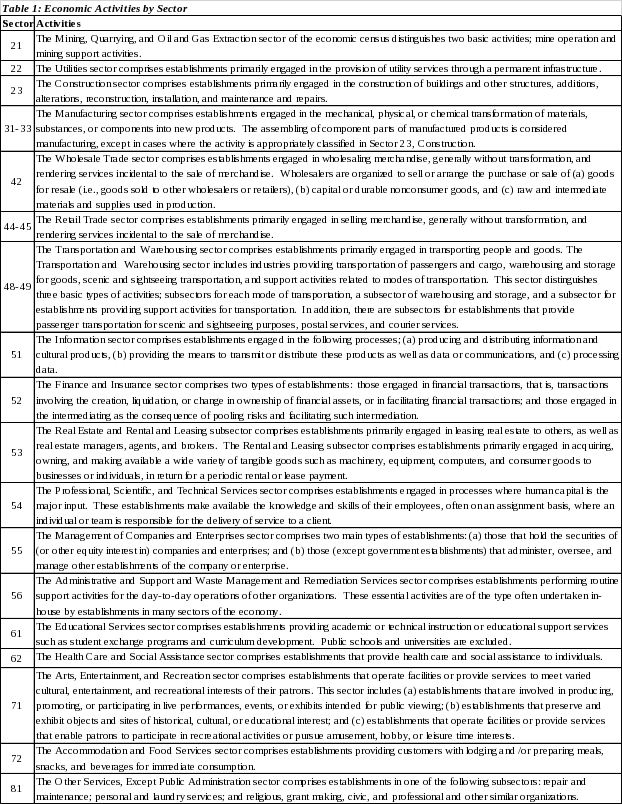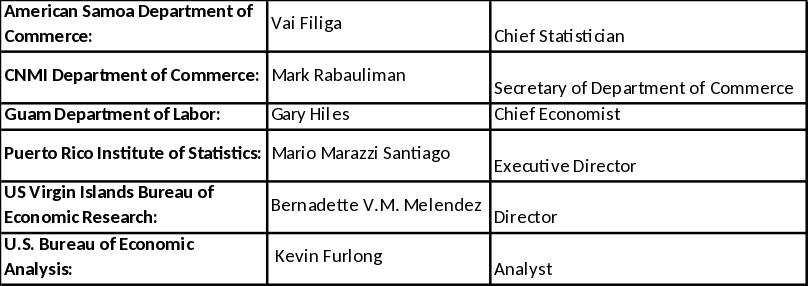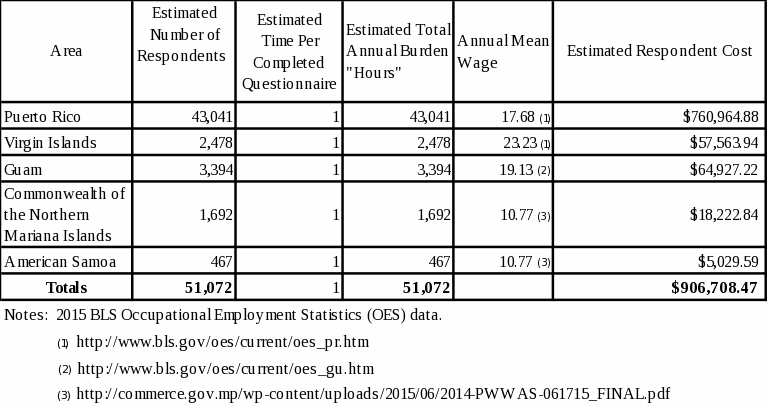IA Supporting Statement A_replan(4)
IA Supporting Statement A_replan(4).docx
2017 Economic Census of Island Areas
OMB: 0607-0937
Department of Commerce
United States Census Bureau
OMB Information Collection Request
2017 Economic Census of Puerto Rico, the U.S. Virgin Islands, Guam,
the Commonwealth of the Northern Mariana Islands, and American Samoa—
Collectively Referred to as Island Areas1
OMB Control Number 0607-0937
Part A. Justification
1. Necessity of Information Collection
The 2017 Economic Census of Island Areas uses direct data collection supplemented by data from Federal administrative records to compile statistics on approximately 51,100 business establishments in industries defined by the 2017 North American Industry Classification System (NAICS) operating in Puerto Rico, Guam, the Commonwealth of the Northern Mariana Islands, the U.S. Virgin Islands and American Samoa. For more information on the NAICS structure see part A Section 19. The enumeration of business establishments located within the 50 states will be submitted separately to the Office of Management and Budget (OMB) for approval.
The Economic Census of Island Areas provides the only source of comprehensive data for the Island Areas at a geographic level similar to U.S. counties. It will produce basic statistics by industry for number of establishments, value of shipments/receipts/revenue/sales, payroll, and employment. It also will yield a variety of industry-specific statistics, depreciable assets, selected purchased services, inventories, and capital expenditures, value of shipments/receipts/revenue/sales by product line as defined by the North American Product Classification System (NAPCS), size of establishments, and other industry-specific measures.
Historically American Samoa, the Commonwealth of the Northern Mariana Islands, Guam, and the U.S. Virgin Islands each received only one general economic census questionnaire to cover all sectors. For the 2017 Economic Census of Island Areas, in an effort to provide all of the territories more complete and comparable data, American Samoa, the Commonwealth of the Northern Mariana Islands, Guam, and the Virgin Islands will receive eight sector group specific instruments, similar to what has been collected for Puerto Rico in prior censuses. The expanded content will cover the following sectors: Utilities, Transportation, and Warehousing; Construction; Manufacturing; Wholesale Trade; Retail Trade; Other Services; Finance, Insurance, Real Estate, Rental and Leasing; and Accommodation and Food Services. The use of forms tailored to the business sector allows for more detailed data collection that is not feasible using one form covering all sectors of the economy. However, the expanded content and additional questions on the sector driven instruments will increase the previous response time for American Samoa, the Commonwealth of the Northern Mariana Islands, Guam, and the Virgin Islands. The new response burden estimate was determined based on cognitive testing done in Puerto Rico, as the instruments are modeled after the forms Puerto Rico has been receiving.
This information collection is part of the 2017 Economic Census, which is required by law under Title 13, United States Code (USC). Section 131 of this statute directs the taking of a census at 5-year intervals. Section 191 defines the geographic scope of the census to include the island areas and Section 224 makes reporting mandatory.
The 2017 Economic Census of Island Areas will cover the following NAICS sectors of the U.S. economy:
Mining, Quarrying, and Oil and Gas Extraction
Utilities
Construction
Manufacturing
Wholesale Trade
Retail Trade
Transportation and Warehousing
Information
Finance and Insurance
Real Estate and Rental and Leasing
Professional, Scientific and Technical Services
Management of Companies and Enterprises
Administrative and Support and Waste Management and Remediation Services
Educational Services
Health Care and Social Assistance
Arts, Entertainment, and Recreation
Accommodation and Food Services
Other Services (except Public Administration)
Although some sectors do not have activity, they are not considered excluded from the Economic Census of Island Areas.
For more details on the NAICS codes included in the 2017 Economic Census of Island Areas, see Section 19 below.
Table 1 describes economic activities covered by the Economic Census of Island Areas.

The economic census will produce basic statistics by industry for the number of establishments, value of shipments/receipts/revenue/sales, payroll, and employment. It also will yield a variety of industry-specific statistics, including expenses, depreciable assets, selected purchased services, inventories, and capital expenditures, value of shipments/receipts/revenue/sales by product line as defined by the North American Product Classification System (NAPCS), type of operation, size of establishments, and other industry-specific measures.
Attachment B provides selected examples of standard questionnaires. All 2017 Economic Census of Island Areas electronic questionnaire instrument paths can be accessed at: http://www.census.gov/programs-surveys/economic-census/information.html
2. Needs and Uses
The Economic Census of Island Areas is the major source of information about the structure and functioning of the economies of each Island Area, and features the only recognized source of data at a geographic level similar to U.S. counties. Economic census statistics serve as part of the framework for the national accounts of the Island Areas and provides essential information for government, business, and the general public. The governments of the Island Areas and the Bureau of Economic Analysis (BEA) rely on the economic census as an important part of the framework for their income and product accounts, input-output tables, economic indices, and other composite measures that serve as the basis for economic policymaking, planning, and program administration. Further, the census provides benchmarks for surveys of businesses which track short-term economic trends, serve as economic indicators, and contribute critical source data for current estimates of the Gross Domestic Product (GDP) of the Island Areas. Finally, industry, business, academia, and the general public use information from the economic census for evaluating markets, preparing business plans, making business decisions, developing economic models and forecasts, conducting economic research, and establishing benchmarks for their own sample surveys.
If the Economic Census of Island Areas were not conducted, the Federal government would lose the only source of detailed comprehensive information of the economies of these areas. Additionally, the governments of the Island Areas would lose vital source data and benchmarks for their national accounts, input-output tables, and other composite measures of economic activity, causing a substantial degradation in the quality of these important statistics.
Information quality is an integral part of the pre-dissemination review of the information disseminated by the Census Bureau (fully described in the Census Bureau’s Information Quality Guidelines). Information quality is also integral to the information collections conducted by the Census Bureau and is incorporated into the clearance process required by the Paperwork Reduction Act.
3. Use of Information Technology
Companies will satisfy their reporting requirement for this information collection by reporting data electronically, using a web-based response driven electronic reporting tool. Companies with more than one location no longer need to download software with a spreadsheet interface or provide data on CDs. For the 2012 Economic Census of Island Areas, approximately 51% of responses were provided electronically. In 2017, respondents are encouraged to report electronically but will be able to request a paper questionnaire and/or receive a follow up of a paper questionnaire in English or Spanish.
4. Efforts to Identify Duplication
Discussions with the island government contacts and BEA confirmed that the data collected during the Economic Census of the Island Areas is unique. The Census Bureau also produces the annual County Business Patterns (CBP) that provides payroll and employment for the island areas at similar NAICS and geography levels. Data for the CBP are sourced from the Company Organization Survey (for Puerto Rico) and administrative data received by the Census Bureau. Data available from the CBP are not comprehensive enough for the BEA to produce GDP estimates for the Island Areas.
5. Minimizing Burden
Federal administrative records for the Island Areas are frequently incomplete and may contain information needing further classification. To compensate for this, the Census Bureau has contracted with the Bureau of Labor Statistics (BLS) to provide industry classification codes for unclassified establishments in the Island Areas. The Puerto Rico Planning Board (PRPB) also provides NAICS codes for establishments for which they have information which the Puerto Rico Institute of Statistics (PRIS) makes available for Census use. With the PRPB codes, the codes provided by the BLS, and historic NAICS codes from the previous Economic Census of Island Areas, we will be better able to exclude businesses that are out-of-scope and reduce response burden by tailoring questionnaires appropriate to the kind of business.
6. Consequences of Less Frequent Collection
The Economic Census of the Island Areas is conducted at 5‑year intervals, as required by Title 13, U.S.C., Sections 131 and 191. If this information collection were conducted less frequently, it would diminish the timeliness and usefulness of the statistics produced. This would cause a corresponding deterioration in the accounts, input‑output tables, economic indexes, business surveys, and other measures for these areas that rely on source data and benchmarks from the economic census. Failure to collect this benchmark data on a 5-year cycle would hinder local and Federal governments in evaluating new programs, disbursing Federal funds, analyzing market trends, and measuring economic performance within geographic areas. Similarly, less frequent collection would reduce the usefulness of the economic census as a source of comprehensive information for economic policymaking, planning, and program administration.
7. Special Circumstances
This information collection will be conducted in a manner consistent with Office of Management and Budget (OMB) guidelines and there are no special circumstances.
8. Consultations Outside the Agency
Consultations with principal data users from each island territory covered occurred throughout 2015 and 2016. We conducted briefings with representatives from American Samoa, the Commonwealth of the Northern Mariana Islands, Guam, Puerto Rico, and the U.S. Virgin Islands to discuss content changes, clarify terms, definitions, and instructions and define data products. BEA was consulted as well. Attachment G provides additional information regarding formal requests that resulted from consultations.

On July 5, 2016 we published a presubmission notice in the Federal Register (Vol 81, No 128, pg.43573-43575) inviting public comment on our plans to submit this request. We did not receive any comments.
9. Paying Respondents
The Census Bureau does not pay respondents and does not provide them with gifts in any form to report requested information in the economic census.
10. Assurance of Confidentiality
This information collection will give respondents the following assurance of confidentiality:
YOUR RESPONSE IS REQUIRED BY LAW. Title 13 United States Code, Sections 131 and 191 authorizes this collection. Section 224 requires your response. The U.S. Census Bureau is required by Section 9 of the same law to keep your information CONFIDENTIAL and can use your responses only to produce statistics. The Census Bureau is not permitted to publicly release your responses in a way that could identify your business, organization, or institution. Per the Federal Cybersecurity Enhancement Act of 2015, your data are protected from cybersecurity risks through screening of the systems that transmit your data.
Similar assurances will be included in the initial contact letter that directs respondents to report Online. (Attachment D).
11. Justification for Sensitive Questions
This information collection asks no questions of a sensitive nature.
12. Estimate of Respondent Burden
Table 2 provides an estimate of respondent burden for each of the Island Areas covered by this request. The number of respondents, by Island Area, are estimates based on in-scope establishments for the 2012 Economic Census of Island Areas and the most recent data available from the Census Bureau’s Business Register; they assume a 100 percent response rate.
Estimates for number of hours per response are based on reasonable estimates of the time needed to read the census questionnaire, the accompanying information sheets, and other materials; to gather, organize, and summarize information; and to record answers on the data collection instrument. These estimates reflect input from cognitive testing conducted in Puerto Rico. Overall, respondent cost for FY 2017 is estimated at $906,709. Table 2 details the estimated respondent cost by island.
Table 2: Estimated 2017 Respondent Cost by Area

13. Estimate of Cost Burden
We do not expect respondents to incur any costs other than that of their time to respond. The information requested is of the type and scope normally contained in company records and no special hardware or accounting software or system is necessary to provide answers to this information collection. Therefore, respondents are not expected to incur any capital and start-up costs or system maintenance costs in responding. Further, purchasing of outside accounting or information collection services, if performed by the respondent, is part of usual and customary business practices and not specifically required for this information collection.
14. Cost to the Federal Government
The cost to the government for this work is included in the total cost of the 2017 Economic Census, estimated to be $657,927,000. This includes all direct and indirect costs associated with the collection, processing, analyses, preparation and publication of statistics from the 2017 Economic Census and Related Programs.
15. Reason for Change in Burden
This collection is being submitted as a reinstatement of an expired collection.
Historically American Samoa, the Commonwealth of the Northern Mariana Islands, Guam, and the U.S. Virgin Islands each received only one general economic census questionnaire to cover all sectors. For the 2017 Economic Census of Island Areas, in an effort to provide all of the territories more complete and comparable data, American Samoa, the Commonwealth of the Northern Mariana Islands, Guam, and the Virgin Islands will receive eight sector specific instruments, similar to what has been collected for Puerto Rico in prior censuses. The expanded content will cover the following sectors: Utilities, Transportation, and Warehousing; Construction; Manufacturing; Wholesale Trade; Retail Trade; Other Services; Finance, Insurance, Real Estate, Rental, and Leasing; and Accommodation and Food Services. The use of forms tailored to the business sector allows for more detailed data collection that is not feasible using one form covering all sectors of the economy. However, the expanded content and additional questions on the sector driven instruments will increase the previous response time for American Samoa, the Commonwealth of the Northern Mariana Islands, Guam, and the Virgin Islands. The new response burden estimate was determined based on cognitive testing done in Puerto Rico, as the instruments are modeled after the forms Puerto Rico has been receiving.
This burden estimate differs from that published in the 60-day Federal Register Notice due to updated and more detailed estimates of the likely number of respondents for each electronic questionnaire path as well as better estimates of the time required to complete the new electronic questionnaires
16. Project Schedule
The Census Bureau will mail questionnaires for this information collection on May 1, 2018, with a due date of June 12, 2018. Mail follow‑ups to nonrespondents will begin in July 2018. These efforts, supplemented by telephone follow-ups to selected nonrespondents, will continue through February 2019. We will check in questionnaires and perform data entry for paper responses until the closeout for data collection operations in February 2019. Receipt of administrative records, automated edits, and initial efforts to resolve reporting problems will continue through February 2019. Then we will prepare tabulations and related analytical summaries, perform analyses, and submit the data to further review and correction. The first release of data products, for American Samoa, the Commonwealth of the Northern Mariana Islands, Guam, and the U.S. Virgin Islands is scheduled to occur in early 2020, and all data dissemination should be complete in early 2021, including Puerto Rico.
Timetable for the 2017 Economic Census of Island Areas
Activity Start1 End1
Receive, process administrative records 05/17 02/19
Identify establishments to be included in the Census 10/17 03/18
Prepare mailing pieces 02/18 04/18
Mail questionnaires 05/18 05/18
Receive and check in responses 05/18 02/19
Perform data entry 05/18 02/19
Edit data, resolve problems 06/18 02/19
Respondent due date 06/18 06/18
Follow-up for nonresponse 07/18 02/19
Close out data collection 02/19 02/19
Prepare and analyze tabulations 07/19 11/21
Data release Early 2020 Early 2021
1All dates are approximate.
Our data dissemination plans summarizing the results of this information collection provide for data to be released similar in number and type to those for the 2012 census. To improve the timeliness, relevance, and usefulness of all data products, the Census Bureau will continue to release economic census data electronically.
Products from this collection will summarize data by kind of business for American Samoa, the Commonwealth of the Northern Mariana Islands, Guam, Puerto Rico, and the United States Virgin Islands. The information collected will produce statistics on the number of establishments; sales, value of shipments/receipts/revenue/sales; annual payroll, first quarter payroll, and employment for the pay period including March 12, 2017. Tabulations will also summarize information by sales size, employment size and industry composition by legal form of organization. A variety of geographic area-specific tabulations for industry-specific statistics will also be included.
17. Request to Not Display Expiration Date
The assigned expiration date will be displayed on all questionnaires and electronic instruments used in this information collection.
18. Exceptions to the Certification
There are no exceptions.
19. NAICS Codes Affected
For the 2017 Economic Census of Island Areas, the following NAICS sectors will be covered:
21 Mining, Quarrying, and Oil and Gas Extraction
22 Utilities
23 Construction
31-33 Manufacturing
42 Wholesale Trade
44-45 Retail Trade
48-49 Transportation and Warehousing
51 Information
52 Finance and Insurance
53 Real Estate and Rental and Leasing
54 Professional, Scientific, and Technical Services
55 Management of Companies and Enterprises
56 Administrative and Support and Waste Management and Remediation Services
61 Educational Services
62 Health Care and Social Assistance
71 Arts, Entertainment and Recreation
72 Accommodation and Food Services
81 Other Services (except Public Administration)
NAICS Exclusions:
6111 Elementary and Secondary Schools
6112 Junior Colleges
6113 Colleges, Universities, and Professional Schools
4811 Scheduled Air Transportation
1 The term used to collectively refer to Puerto Rico, the U.S. Virgin Islands, Guam, the Commonwealth of the Northern Mariana Islands, and American Samoa in the Federal Register on June 7, 2011 was Island Areas. Island Areas is common terminology across the Census Bureau.
| File Type | application/vnd.openxmlformats-officedocument.wordprocessingml.document |
| Author | Shelby Plude |
| File Modified | 0000-00-00 |
| File Created | 2021-01-21 |
© 2026 OMB.report | Privacy Policy